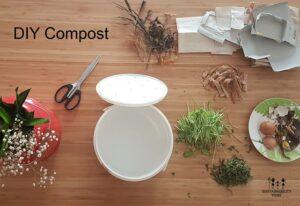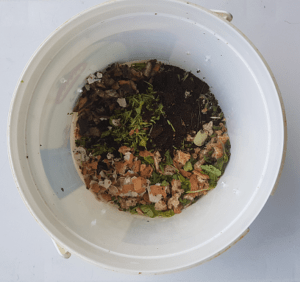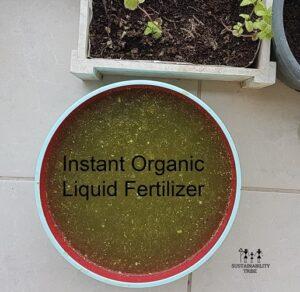If you are raised in a place popular for farming and have green fingers inherited from your grandparents, you can never give up on gardening and grow something green! That’s exactly is my story and moving to UAE didn’t stop my passion for gardening. Though my gardening skills are limited to a small container garden I started exploring ways of thriving my plants or even sustainable ways of growing edible plants like vegetables, herbs in this challenging weather.
WHY ORGANIC OR NATURAL FERTILIZERS?
Generally, all sort of plants needs fertilizers. If you are gardening in UAE where there is no natural fertile soil available and you need to depend on store-bought soil. Harsh weather throughout the year makes it even more difficult to grow and thrive in the plants in UAE. More the challenges in growing and gardening, there is a bigger need for fertilizers or the right care of plants.
Plants need nutrients like phosphorus, etc but it’s better to provide them these nutrients through natural sources than an artificial one. Natural fertilizers build healthy soil and foster soil-microorganism that promotes healthier plants and root development. Whereas manufactured chemical fertilizers grow plants but do nothing to sustain the soil. The fillers do not promote life or soil health.
Also, chemical fertilizers contain many toxic heavy metals that have adverse effects on human health. Heavy metals such as Mercury, Lead, Cadmium, and Uranium have been found in fertilizers, which can cause disturbances in the kidneys, lungs, and liver and cause cancer. Ammonium Nitrate exposure causes other health problems such as eye and skin irritation, producing a burning sensation. One can also experience nausea, vomiting, flushing of the face and neck, headache, nervousness, uncontrolled muscle movements, faintness, and collapse. Potassium Chloride interferes with nerve impulses, and interrupts with virtually all bodily functions and mainly affects heart functioning. Cadmium: Ultimately enters the human tissues resulting in diseases such as tracheobronchitis, pneumonitis, pulmonary edema, renal failure, osteoporosis, and many others.
But apart from the statistics and proven adverse effects of manufactured toxic fertilizers, I would also like to bring attention to the philosophy behind natural organic fertilizers here: The whole idea of growing your own food in your garden is about the slow food, where you tend to your plants, soil and get the joy of growing your food then naturally we are not looking into taking a risk of adding harmful chemical in our beautiful natural green patch just to get the fast result right?
Here are some of my triest and tested recipes of natural fertilizers made at home.
DIY COMPOST AT HOME
For this easy DIY compost at home, you need to find a large container, I decided to repurpose an old yogurt container.
You need to drill the holes around the periphery of the box and on the lip of the box. This for letting your compost breath.
The next step is collecting wet and dry organic waste.

Wet or green organic waste:
You can add all sorts of fruit and vegetable scraps like peels of banana, discarded stems of vegetables, used coffee ground, etc. Just make sure to avoid milk products and I also preferred avoiding meat products.
Dry or brown Organic waste:
In this, you can use dried eggshells, onion and garlic peels, dried leaves, and sticks from your garden. You can also use brown paper but make sure it’s not plastic coated or does not contain chemicals like ink etc.

Once you gather all your dry and wet organic waste, make sure to chop it into small pieces or you can even crush it or grind it to make sure it will decompose faster. Mix both your dry and wet organic matter into the composting box along with some soil.
You can now keep the box covered in a sunny spot of your balcony. You need to turn the mix least once a week, more you turn quicker your compost will be ready. Also, keep watch if the compost is becoming too wet, then you can add some drier organic waste or soil. Also, believe me, it doesn’t smell bad at all. If your compost is smelling bad, something is not right. When my compost was finally ready, it was smelling like fresh soil.

It took me more than a month to get my compost ready. Of course, it took a few trial and errors for me, I didn’t get results in the first go. Here are some of the mistakes I am listing, so that you can avoid those.
Use coffee ground in limited quantity. Else your compost will become acidic.
Dry your eggshells, else they will take longer to decompose.
Grind or chop very find your organic waste, else it takes really long to get results.
Have more dry or brown waste than green or wet waste.
Don’t forget to turn your mixture, I forgot for a while and the result was fungi and bad smell.
Too much wetness can result in tiny white worms (not earthworms, they are good), they are called pot worms, they are not harmful but they don’t really help either. These worms thrive in a high moisture environment. The solution to getting rid of these worms, which worked for me is the power of dried eggshells. Also not adding soil, didn’t work for me.
Here is my review of a store-bought easy composting unit, Gobble composter, which helps in composting almost all sorts of organic waste at home.
INSTANT ORGANIC LIQUID FERTILIZER
If you don’t want to go on the path of creating your own compost, but you can’t afford to invest much time in it then you can also try this quickest natural fertilizer recipe. I prefer doing it over the weekend and my fertilizing task is done.
Collect all sorts of green waste include as many fruits and vegetable scraps. More variety of fruits and vegetables better nutrients your plants can get. Examples are banana peel rich in potassium and phosphorus, orange peels, scraps of leafy vegetables, vegetables, and fruits peels and scraps, etc.

Make sure to chop all the fruit and vegetable scraps. Now in a blender add all the chopped green waste and water and blend it to make a smoothie, make sure no lumps are present. Once you get a thin smoothie-like juice, then dilute it with at least 4 to 5 times of water. Just feed this mixture to plants instead of watering plants. Feed this nutrient-rich instant liquid fertilizer at least twice in a month to your flowering and edible plants, you won’t need any other fertilizers.
EGGSHELLS
Eggshells are my most favorite natural fertilizers. Eggshells are the rich organic source of calcium carbonate which is very beneficial for growing of tomatoes, tomato, pepper, eggplants, lettuce, etc. But for other plants as well eggshells are great fertilizers. To use eggshells as fertilizers remember to dry the eggshells in sun for a few days after that you can just crush or grind them to make powder and feed them to your plants.
But do you know eggshells are also useful in your garden for different applications? Eggshells are great as mulch and eggshells also act as pesticide or insecticide. Instead of making a fine powder of dried eggshells, you can grind them coarse to use as a pesticide.

Eggshell as a seed starter
Another great use of eggshells is seed starters, you can wash and dry eggshells, fill up some soil and use it as a seed starter, once the seedlings are ready to be planted you can directly plant the egg seed starter in the soil, which will also act as a fertilizer.
Because of so many uses of eggshells, I rarely throw away eggshells in the garbage.
SALTS AS NATURAL FERTILIZER
Epsom salt is also one of the best natural fertilizers just make sure to choose the natural Epsom salt without any added flavors to avoid any added chemicals. Epsom salt is a great source of magnesium and sulfur. Epsom salt increases the overall health of a plant, increases output in terms of more flowers or bushier plants or tastier and juicier fruits. Epsom salts are more effective for sandy soil, which is more likely to find in UAE as you may have noticed if you buy a potted plant here, many times it is layered with sand on the top. There are many ways you can use Epsom salt from germination to growing to fruiting stages of a plant. I generally prefer to dilute Epsom salt in water and water it to plants in my balcony garden once in a while.

QUICK FERTILIZERS FROM THE KITCHEN
There are so many kitchen wastes that can be used in your garden as fertilizers, here are some of my favorite tips
The drained salty water of pasta- this salt-rich water I never throw down the sink, it is great for chilies.
Any water in yogurt is a great feed for curry leaves, traditionally we feed buttermilk to curry leaves for better taste.
Any leftover cooking water after steaming of vegetables or discarded water in a pressure cooker or Leftover water from hard-boiled eggs is a great instant fertilizer for plants.
The modest amount of coffee grounds can provide nitrogen and minerals to plants. You can just burry the chopped banana peel under the soil and it can decompose and fertilize the plant.
Now all above natural fertilizers don’t just help to grow your organic garden but also reduce waste going to landfill from your home and re-use it for growing plants. That’s why these are also great tips for going zero waste. Next time you are throwing away anything organic, I would suggest just find out if it can be useful in your garden?
Happy gardening! If you haven’t already then join our tribe here.

